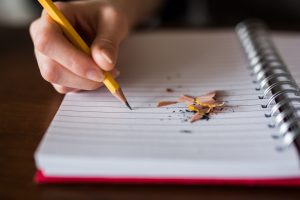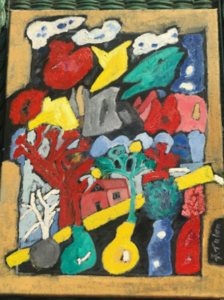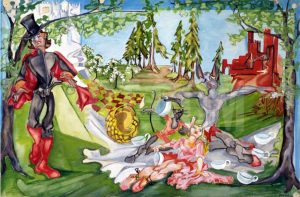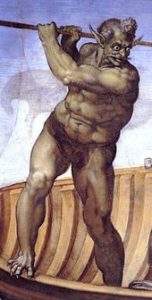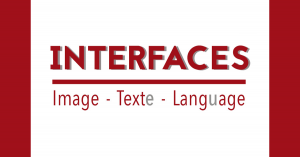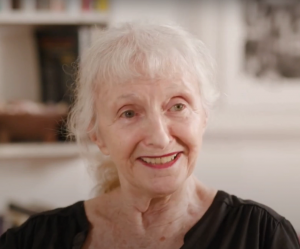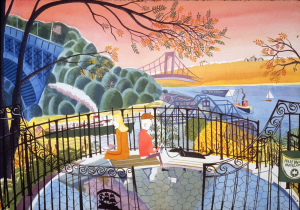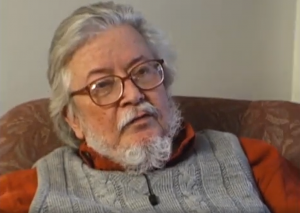How To Write Better: Borrowing From Chemistry
Better Writing Through Chemistry In 1935, Dupont promised they’d bring us better living through chemistry. Today, the phrase is used ironically for movie and album titles and most especially to describe recreational drug use. Acknowledging that chemistry has improved our lives is bromidic. Less well known is that the chemical lexicon, demonstrably miscible with our…
Read MoreDawg blawg
Although I had tried to make The Writer’s Brush: Paintings, Drawings, and Sculpture by Writers as comprehensive as possible, as I acknowledged in the preface, I knew that with new writer-artists appearing every day that it would be out of date as soon as it was published. Omissions were partially rectified with two large exhibitions…
Read MoreWriter-Artists
We’ve all had those head-thumping moments—coming up with the crushing argument when our adversary is long gone, remembering the ingredient left out of the casserole, the part that should have been done or installed before the part just finished with. Many such omissions are fixable, even if at some cost or inconvenience. But imagine writing…
Read MoreFREDERIC TUTEN FOUND A NEW JOY
“At this time of my life–someone would say, the winter of my life, although I don’t feel cold,” Frederic Tuten, novelist, essayist, short story writer, and art critic, tells of finding a new joy in painting. “Practically no day passes where I’m not either writing and painting or painting and writing, whichever comes first in…
Read MoreWHY IS THIS NIGHT DIFFERENT FROM ALL OTHER NIGHTS? PASSOVER 2023
Why is this night of Passover,2023, different from all other nights? Because this celebration of the Exodus, a symbol to peoples everywhere—Jews and Christians alike–who’ve won the hard fight for freedom, is being overshadowed in Israel itself by a group of democracy-suppressing, racist, and violent Jews. Because, after centuries of Seders, of praying for return…
Read MoreRALPH STEADMAN: “GENIUSES ARE REALLY LOSERS WHO TRY HARDER.”
The genius of Ralph Steadman can be found in the more than 50 books he’s written or illustrated (or both written and illustrated), in his famous partnership with Hunter Thompson and the creation of Gonzo journalism—the two not just covering a story but becoming it. “Bats over Barstow,” reproduced here, is one of his drawings…
Read MoreZELDA’S LEGACY
On March 10, 1948, at 48, Zelda Fitzgerald, widow of F. Scott, died in a fire in a locked hospital room during the last of her many confinements for chronic mental illness. Variously diagnosed as schizophrenia and bi-polar disorder, at least one biographer asserts that a major objective of her treatment was to restore her…
Read MoreWATCHING, WASHING, WRAPPING AND TALKING TO THE DEAD
My partner, a very smart and level-headed woman, routinely paid large sums by corporate leaders to help them strategize, recently informed me she had volunteered to spend hours minutely washing an old woman’s corpse in preparation for burial. It is a Jewish ritual called Tahara. After the cleaning, the body was dressed in a white…
Read MoreMY CONTRIBUTION TO THE LATEST INTERFACES ISSUE
Voilá, the latest issue of INTERFACES, internationally renowned journal of text and image and my contribution to it–an extended essay on writer and conceptual artist Roberta Allen along with an on-camera interview with her in 2021. Note this is not the brief commentary previously posted but an expanded discussion of the prolific author Allen and her…
Read MoreRoberta Allen: “Language is the bridge…”
“Language is the bridge…” Roberta Allen began making and exhibiting her conceptual art more than a half century ago, before she came to author eight books and more than 200 works of short fiction. Indeed, as she explains in this 2021 interview, her earliest writing was about her art. Allen had her first solo exhibition…
Read MoreThe Two Sides of Peter Selgin
A two-fisted writer-artist, Peter Selgin, award-winning novelist, essayist, memoirist, and short story writer, earned his living as a freelance artist for thirty-six years, before deciding to abandon the visual arts for the literary in 2009. By 2014, well into his writing career and established as a professor of creative writing he realized he could not separate the writer from the artist. That they needed each other.
Read MoreENJOY THE LATEST ISSUE OF INTERFACES
Voilá, the latest issue of INTERFACES, internationally renowned journal of text and image. This issue focuses on format. By that is meant the vehicle selected by a creator — a writing or a painting, for example — to express her ideas. Included is my extended essay and on-camera interview with Fernando del Paso, among the greatest Spanish language novelists of the last 100 years, who began drawing to kill time between news reports while working at the BBC and before he knew it was being exhibited alongside leading figures in the art world. Also included is my review of “The Lehman Trilogy,” which utilizes a stripped-down set and localizes and identifies characters through language, and telescopes more than a century into a few hours. Click on the link and enjoy!
Read MoreFernando del Paso: “I dream that I paint, and I paint the dream.”
With the 2015 award of the Cervantes Prize, Fernando del Paso’s place among the greatest of Spanish literary figures was cemented. Acclaimed as both novelist and essayist, the Surrealist-influenced del Paso was also an internationally exhibited artist whose work, both in ink and paint, offers precisely rendered, dream-like images that juxtapose and merge the real and the fantastic.
Read More